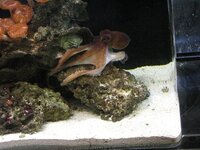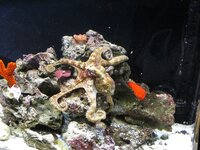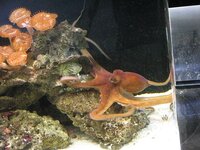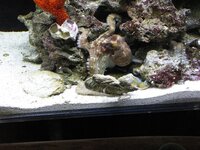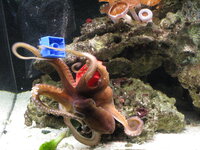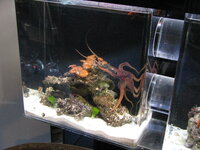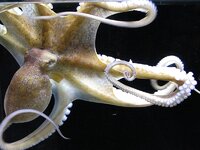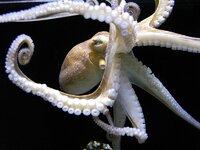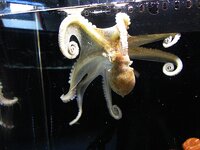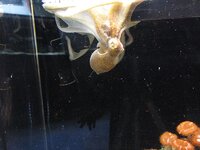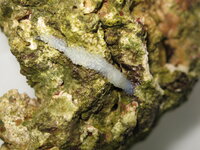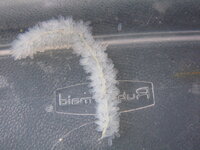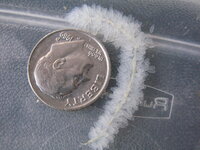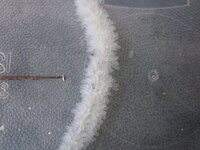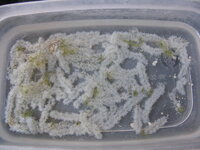yeah, yeah, yeah ... but if I called her a giant joubini then her name would not fit her.
You are using an out of date browser. It may not display this or other websites correctly.
You should upgrade or use an alternative browser.
You should upgrade or use an alternative browser.
When we moved Diego to the breakfast room tank, I moved the cowrie to the tube tank. I was not sure how well a Caribbean cowrie would do in constant colder temperatures and Joe-Ceph has reported a potential issue with molestation and one of his bimacs (this cowrie has lived with at least two O. briareus). This afternoon I passed by Little Bit's tank and saw her positioned in front of the tank with her web full. Initially I thought she found a clam. I often keep live clams in the tanks that are available for snack but are usually ignored by other octos after eating exactly one. Little Bit, however had eaten all in her prior tank and immediately opened another I offered before the move. The clams I usually use are fairly small and she looked over extended so I took a closer look. I did not take time to photograph what I found! Because the cowrie is so large (about 1.5 her mantle length and about the sam diameter) and has a hard shell, I was able to take it from her without a problem and I know she had not had it long because I had looked in on her less than an hour before. Oddly the cowrie did not retract its mantle, even when I picked it up (usually a touch on the mantle will cause it to retract). It seems to be OK but I wonder if Little Bit injected poison that would cause a temporary inability to retract the mantle as well as for the animal to retract into its shell. The back coloration is splotch white but so far it seems to be OK and is moving in the LR in the new guy's (O. briareus baby) tank and I will watch it closely to be sure it does not die.
I checked on the cowrie again and after an hour it is busily eating along the tank wall but the posterior mantle is still splotch white with a few white circles closer to the head. Embarassingly , I am not sur if this is a common coloration but I have not noted it in the past. I have not touched the mantle to see if it will retract but will try that in another hour.
, I am not sur if this is a common coloration but I have not noted it in the past. I have not touched the mantle to see if it will retract but will try that in another hour.
One more check on the cowrie. I touched the mantle without response but when I tapped on it on it where the color is brown, it did retract. After the first reaction, gentler touch continued to activate retraction and then coverage so I think any effects are temporay. The posterior is still quite white but seems (hind-sight - No comparison photos ) to be becoming more brown.
) to be becoming more brown.
There was no evidence of slime. I had noticed a gel-like slime in my filter sock at some point early in keeping the cowrie. Joe-Ceph's comments make me believe the cowrie was the originator. After roughly a month (again, no documentation) it stopped and I have never seen it again. I don't know if this is a reproductive or defensive material but I am inclinde to think the former. Time for some research Nope, it appears they lay eggs and there is no mention of gel/slime in the mating process but I did find a reference that says they can produce copious amounts of slime
Nope, it appears they lay eggs and there is no mention of gel/slime in the mating process but I did find a reference that says they can produce copious amounts of slime 
I checked on the cowrie again and after an hour it is busily eating along the tank wall but the posterior mantle is still splotch white with a few white circles closer to the head. Embarassingly
One more check on the cowrie. I touched the mantle without response but when I tapped on it on it where the color is brown, it did retract. After the first reaction, gentler touch continued to activate retraction and then coverage so I think any effects are temporay. The posterior is still quite white but seems (hind-sight - No comparison photos
There was no evidence of slime. I had noticed a gel-like slime in my filter sock at some point early in keeping the cowrie. Joe-Ceph's comments make me believe the cowrie was the originator. After roughly a month (again, no documentation) it stopped and I have never seen it again. I don't know if this is a reproductive or defensive material but I am inclinde to think the former. Time for some research
All of those look like patterns Pen commonly displayed.
No question she can do most of the vulgaris patterns (I have not seen the veined one though) but I believe this is expected in joubini. I will probably go back and reread the paper posted in the biology section to see if I can discount the call but she is way too small for vulgaris and only a little too large for joubini. After keeping her 6 months + she is still smaller (arms and mantle girth but not length) than our largest hummelincki, Octane but as large or larger than the others. Norman mentions the arm bands you can see in picture #1 above and her red coloring (the paper talks about the red being different than the merc red).
I would like to be able to find these on an on-going basis (Little Bit was serendipitous and a one-time find). Other than being small egged, they are probably ideal for home keeping if they would stay the size they are supposed to . In spite of the write-ups saying they are nocturnal (not a characteristic mentioned in Norman) Little Bit is active after about 2:00PM with naps and waking periods up until about 11:00. On rare occasions I will see her out after lights out but her typical alert time is not after dark. I believe the labeling is a result of the confusion of O.joubini with O.mercatoris.
. In spite of the write-ups saying they are nocturnal (not a characteristic mentioned in Norman) Little Bit is active after about 2:00PM with naps and waking periods up until about 11:00. On rare occasions I will see her out after lights out but her typical alert time is not after dark. I believe the labeling is a result of the confusion of O.joubini with O.mercatoris.
She is also likely the strongest octopus we have kept. Additionally, she has a totally different interaction approach. She remains fiesty but does want human attention or at least to use our hands to shed her suckers.
We decided to try the legos with her as an "enrichment". It took her two seconds to separate the blocks, grab her food and about two minutes to decide the blocks, without food were boring and discarded them with no additional interest.
I would like to be able to find these on an on-going basis (Little Bit was serendipitous and a one-time find). Other than being small egged, they are probably ideal for home keeping if they would stay the size they are supposed to
She is also likely the strongest octopus we have kept. Additionally, she has a totally different interaction approach. She remains fiesty but does want human attention or at least to use our hands to shed her suckers.
We decided to try the legos with her as an "enrichment". It took her two seconds to separate the blocks, grab her food and about two minutes to decide the blocks, without food were boring and discarded them with no additional interest.
Attachments
I am not sure what to expect of Little Bit. At the moment, she easily spans one side of the tube tank. Neal and I both think she has started a growth spurt similar to the doubling you see with hatchlings. This is not supposed to happen at 8 months (guessing a little here since we have had her over 6 months and it takes a month before they are benthic) old. It is not just her mantle (that would not be strange at this age for a female if she was manufacturing eggs) but he arm length is apparently increasing dramatically as well. I need to find some of the studies that have successfully raised vulgaris from hatchlings to see if there are any comments about a second growth spurt. I am not sure any of them were successful in keeping them alive this long though  and the ones we have seen on TONMO have started at about her size now. Fortunately, the large tank has no current resident (other than my food market conch who must be moved after seeing the cowrie attack) that would preclude moving her if this continues.
and the ones we have seen on TONMO have started at about her size now. Fortunately, the large tank has no current resident (other than my food market conch who must be moved after seeing the cowrie attack) that would preclude moving her if this continues.
This is frustrating. I can find lots of information on paralarvae raising (mostly failures and the successes are minimal) but the oldest from paralavae that I have seen mentioned is 180 days and it is after a known 6 months that I would like growth information
 and the ones we have seen on TONMO have started at about her size now. Fortunately, the large tank has no current resident (other than my food market conch who must be moved after seeing the cowrie attack) that would preclude moving her if this continues.
and the ones we have seen on TONMO have started at about her size now. Fortunately, the large tank has no current resident (other than my food market conch who must be moved after seeing the cowrie attack) that would preclude moving her if this continues.This is frustrating. I can find lots of information on paralarvae raising (mostly failures and the successes are minimal) but the oldest from paralavae that I have seen mentioned is 180 days and it is after a known 6 months that I would like growth information
As you can see from the video, Little Bit is not so little any more.
Sadly, after 7 months I am afraid I am losing her. Tonight I noticed her eyes look swollen but not with the look of infection. One eye she keeps closed and the other has the look of a cateract (milky white in the black, this I have been seeing for a week or more). I also noticed frequent jerks in her motions as she hunted in the LR, another sign (unknown cause) I have seen at the end of their lives. Tonight she has chosen to sleep in the tube that joins the tanks. When I have seen my other octopuses moving out of their dens and on to a wall or other open above ground locations, it has been to avoid the clean up crew that always detect a dieing animal. Her breathing is not labored but I feel certain we are approaching the end. She has been active and eating well and has not brooded so I would not call this a normal old age ending. If she is, as I have thought, a dwarf species, her excessive size may have something to do with the shortened lifespan.
Sadly, after 7 months I am afraid I am losing her. Tonight I noticed her eyes look swollen but not with the look of infection. One eye she keeps closed and the other has the look of a cateract (milky white in the black, this I have been seeing for a week or more). I also noticed frequent jerks in her motions as she hunted in the LR, another sign (unknown cause) I have seen at the end of their lives. Tonight she has chosen to sleep in the tube that joins the tanks. When I have seen my other octopuses moving out of their dens and on to a wall or other open above ground locations, it has been to avoid the clean up crew that always detect a dieing animal. Her breathing is not labored but I feel certain we are approaching the end. She has been active and eating well and has not brooded so I would not call this a normal old age ending. If she is, as I have thought, a dwarf species, her excessive size may have something to do with the shortened lifespan.
Attachments
Little Bit is still with me, is still fiesty, very active and eats like a horse but at rest she is quite gray and when active I can see spots where the chromataphores no longer function. She flirts daily with Diego (who is coming our much more during the day now) and I will often see both of them dancing at the front of their tanks when no one has been in the room.
She is getting a bit demanding in her old age and if we are late with dinner, you can count on taking a saltwater bath. She is still very strong and can shoot water about 6' (LOTS of water). She has even managed to show her displeasure on her fast day by shooting water through the holes in the acrylic top so that it dribbles down the sides and leaves streaks all over the tank.
She still plays "grab the human and shed" daily but behaves fairly well when I clean her tank if I pretend to ignore that fact that an octopus is attached to my arm. The difference in behavior when I clean and ignore her vs when I play with her has me believe that she enjoys her human contact game. This coupled with the fact that she almost always comes out and goes to the front when we pass through the room (and that she does not bite) suggest that the contact is not as aggressive as it seems but her way of interacting.
She still has not given the first hint of brooding but her eyes have problems. She can open them and can see but she keeps them open only slightly and they appear sunken, sometimes to the point where I wonder if they are gone (but they are not). This does not look like infections I have seen so I have not tried treating her with antibiotics but I don't believe it is a normal aging affliction. Since it involves the eyes, I wonder if the gland in the optic nerve is also effected and is the reason she has not brooded.
Joubini has a recorded different brood cycle from most octopuses we keep and I wonder if they brood at all if they have not mated. The paper I posted in the biology thread on joubini mentions that they lay eggs over a period of time and that the first ones hatch about the time the last ones are laid. I believe it also mentions eating through out the brooding cycle. Sedna's animal never showed signs of brooding and was totally surprised when she had hatchlings. This won't be the case with Little Bit though unless Diego is sneaking out of his tank and stealthily returning while we sleep
She is getting a bit demanding in her old age and if we are late with dinner, you can count on taking a saltwater bath. She is still very strong and can shoot water about 6' (LOTS of water). She has even managed to show her displeasure on her fast day by shooting water through the holes in the acrylic top so that it dribbles down the sides and leaves streaks all over the tank.
She still plays "grab the human and shed" daily but behaves fairly well when I clean her tank if I pretend to ignore that fact that an octopus is attached to my arm. The difference in behavior when I clean and ignore her vs when I play with her has me believe that she enjoys her human contact game. This coupled with the fact that she almost always comes out and goes to the front when we pass through the room (and that she does not bite) suggest that the contact is not as aggressive as it seems but her way of interacting.
She still has not given the first hint of brooding but her eyes have problems. She can open them and can see but she keeps them open only slightly and they appear sunken, sometimes to the point where I wonder if they are gone (but they are not). This does not look like infections I have seen so I have not tried treating her with antibiotics but I don't believe it is a normal aging affliction. Since it involves the eyes, I wonder if the gland in the optic nerve is also effected and is the reason she has not brooded.
Joubini has a recorded different brood cycle from most octopuses we keep and I wonder if they brood at all if they have not mated. The paper I posted in the biology thread on joubini mentions that they lay eggs over a period of time and that the first ones hatch about the time the last ones are laid. I believe it also mentions eating through out the brooding cycle. Sedna's animal never showed signs of brooding and was totally surprised when she had hatchlings. This won't be the case with Little Bit though unless Diego is sneaking out of his tank and stealthily returning while we sleep

Sadly, after 8 months with me, it is LittleBit's time to brood. She has been flirting regularly with Diego (they dance on the glass in clear view of each other when no one is around) and you can't help but feel sure they know they are both octopuses and are opposite sexed. With her loss of color and eye issues, I was not sure she would go through the typical brooding procedures but there is no mistake she is preparing to lay eggs. Neal questioned my call until yesterday when she was, for the first time, not looking for food at dinner time. She has come out of her prepared den a few times has not stopped taking food (assuming she ate the offering today that she took into her den - new behavior).
This video was shot on the Dec 17th when I first felt sure she was starting to built a brood den. The video itself is not interesting but notice the slime sticking the sand together. It is most noticable near the front bottom just in front of the right hand shell. She was cleaning out this area when I provided a crab and does take it if you look closely but the slime started before the food was noticed.
This video was shot on the Dec 17th when I first felt sure she was starting to built a brood den. The video itself is not interesting but notice the slime sticking the sand together. It is most noticable near the front bottom just in front of the right hand shell. She was cleaning out this area when I provided a crab and does take it if you look closely but the slime started before the food was noticed.
These are pictures from the end of October and you can see that her color is fading. Not overly clear in the pictures are the white spots that no longer color at all. For the last couple of months she seemed to be hungry most of the time and would skim the surface of the tank for food in addition to her normal meal. As we often see in aging animals, she would often take a position in front of moving water. The photo of her upside down and not spread out shows her both skimming the surface and sitting in front of a water return pipe (the return alternates left to right in the tank). She has always been fiesty (much less so for the last week and now not at all) but if we were late to feed her (any time past 6:00 PM) you could count on getting a face full of water and a slippery floor. After she secured the offered food she would grab the feeding hand with gusto and often come part way out of the tank. I am not sure if this was to indicate she wanted more or just her aggressive interaction mode on hyper drive.
I will look for eggs in the AM and PM (I expected to find some today but could not see any) and remove them. They will not be fertile and there is a slight chance she will not stay in her den until the end if they are removed quickly.
I will look for eggs in the AM and PM (I expected to find some today but could not see any) and remove them. They will not be fertile and there is a slight chance she will not stay in her den until the end if they are removed quickly.
Attachments
Small egg photos
Sadly, we have only seen arms from Little Bit for the last week. She is still eating but now takes the shells and removes them from her den (she would just leave them where she ate them before) and her strength is noticably diminished when she grabs a hand (there may be other reasons she does not grab as tightly though). I have been checking for eggs daily but forgot to check on 12/30. I did check yesterday (12/31) and found this single strand (guesimate would be 350-400 eggs). If the paper I read on joubini holds true she may continue to lay them over the next week or more.
As noted, and obvious if you viewed the first of the thread, these are not fertile. There is a small chance that removing them will let us see her out more often but I don't believe this will be the case.
The eggs look very much like the small worms we seen in the LR that gather sand to make a housing. Contrasted to O.briareus eggs, this cluster has one stem with many eggs where O. briareus (large egg) I have seen laid in two ways, one with a continuous stem like this (stem color is greenish/yellow/brown) and eggs individually glued to the wall in small clusters.
Sadly, we have only seen arms from Little Bit for the last week. She is still eating but now takes the shells and removes them from her den (she would just leave them where she ate them before) and her strength is noticably diminished when she grabs a hand (there may be other reasons she does not grab as tightly though). I have been checking for eggs daily but forgot to check on 12/30. I did check yesterday (12/31) and found this single strand (guesimate would be 350-400 eggs). If the paper I read on joubini holds true she may continue to lay them over the next week or more.
As noted, and obvious if you viewed the first of the thread, these are not fertile. There is a small chance that removing them will let us see her out more often but I don't believe this will be the case.
The eggs look very much like the small worms we seen in the LR that gather sand to make a housing. Contrasted to O.briareus eggs, this cluster has one stem with many eggs where O. briareus (large egg) I have seen laid in two ways, one with a continuous stem like this (stem color is greenish/yellow/brown) and eggs individually glued to the wall in small clusters.
Attachments
- Joined
- Oct 2, 2009
- Messages
- 1,462
Wow those are tiny.
I am sorry shes not doing very well.
I am sorry shes not doing very well.
Many more eggs today. I will get photos up tomorrow. I have (and will continue to) removed them to see if when she finishes if she will come out again rather than brood. The eggs she laid today were on the back wall rather than on the rocks. She was not crazy about me removing them but did not attack. She did reach for my hand and the turkey baster but never tried to bite or even pull with the strength I think she still has. However, she took but did not eat her crab claw tonight. This is likely the first time she has not eaten what was offered (she is fed 6 days a week, is always hungry and often gets something little on her fast days).
Attachments
We do see a little more of her now and I have seen her on both sides of the tank at night. She seems to be dancing with Diego again but not as often or as long.
We usually attribute weakness to not eating but her grip has changed over night and it cannot be from lack of food intake. She will let me "tickle" her suckers but not pet her otherwise (she only allowed a little petting just below the eyes prior to brooding and was never as interactive with our hands as other species). She sleeps a lot more and sometimes I wonder if she is hunting for her eggs the way she will move her arms in and out of the live rock. I think I have gotten her to eat a shelled crab claw and a small piece of shrimp but it took a lot of coaxing and putting the food directly at her mouth. I could not find it in the tank but the serpent/brittle stars could account for that. Tonight, however, we did see her elminate so she has eaten something (could be Cyclop-eeze though as I have had other post broods eat that when nothing else would be accepted and we have seen her skim it from the water in the past).
One interesting thing that happened when I was removing her eggs that I wanted to record. There is a pencil urchin in the tank and it was feeding at the bottom of the overflow box at the water line. When I started scraping the eggs off the back wall, it started spawning. I caught some of it on tape but the video is not really good enough to post. The spawning stopped when I quit but started again when I continued. Neal thinks it is cooincidence, I don't.
We usually attribute weakness to not eating but her grip has changed over night and it cannot be from lack of food intake. She will let me "tickle" her suckers but not pet her otherwise (she only allowed a little petting just below the eyes prior to brooding and was never as interactive with our hands as other species). She sleeps a lot more and sometimes I wonder if she is hunting for her eggs the way she will move her arms in and out of the live rock. I think I have gotten her to eat a shelled crab claw and a small piece of shrimp but it took a lot of coaxing and putting the food directly at her mouth. I could not find it in the tank but the serpent/brittle stars could account for that. Tonight, however, we did see her elminate so she has eaten something (could be Cyclop-eeze though as I have had other post broods eat that when nothing else would be accepted and we have seen her skim it from the water in the past).
One interesting thing that happened when I was removing her eggs that I wanted to record. There is a pencil urchin in the tank and it was feeding at the bottom of the overflow box at the water line. When I started scraping the eggs off the back wall, it started spawning. I caught some of it on tape but the video is not really good enough to post. The spawning stopped when I quit but started again when I continued. Neal thinks it is cooincidence, I don't.
- Joined
- Oct 15, 2011
- Messages
- 258
It's so sad that the eggs aren't fertile. I would've been happy to see another generation and have Little Bit's purpose live on and continue. But I'm also happy that you have had a blast with her, I'd be proud.
Similar threads
- Replies
- 19
- Views
- 2K
- Replies
- 21
- Views
- 2K
- Replies
- 148
- Views
- 5K

